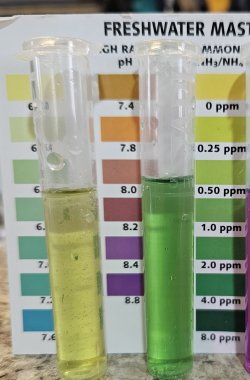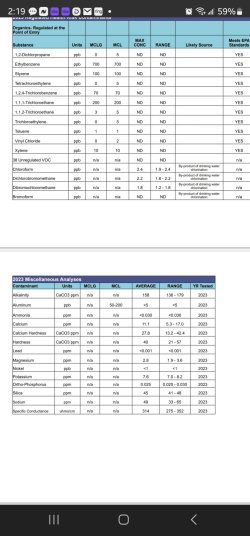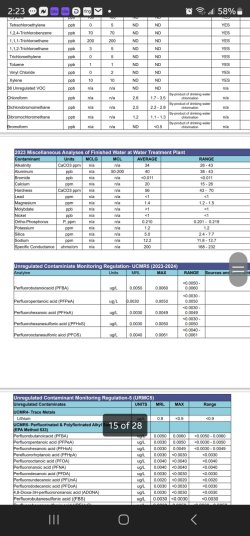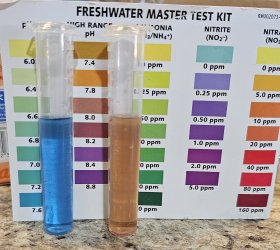Yes, if it's zero tomorrow, wait till Saturday to make sure it's still zero. If it not zero tomorrow but it is zero on Saturday, wait to check it's still zero on Monday. And so on.
You are using an out of date browser. It may not display this or other websites correctly.
You should upgrade or use an alternative browser.
You should upgrade or use an alternative browser.
65 gallon cycle help
- Thread starter Fishyone2
- Start date
Fishyone2
New Member
Okay and after those 2 consecutive of 0 ammonia then I would add the 120 dropYes, if it's zero tomorrow, wait till Saturday to make sure it's still zero. If it not zero tomorrow but it is zero on Saturday, wait to check it's still zero on Monday. And so on.
Okay got itYes, if it's zero tomorrow, wait till Saturday to make sure it's still zero. If it not zero tomorrow but it is zero on Saturday, wait to check it's still zero on Monday. And so on.
Wait for ammonia to hit 0 for 2 consecutive days, if and when that happens dose the 120 drops.
Then test everyday until ammonia is .25ppm and nitrite is 1ppm or below and then dose the 360 drops and let both fall to zero and then do that again. If both ammonia and nitrite falls to 0 in 24hrs its cycled
I feel like I over complicated this whole process lol I really appreciate you taking time to dumb it down for me
Fishyone2
New Member
I know you said to wait on testing but I decided to test my PH and seems I've had a PH drop. What do I do for that?Yes, if it's zero tomorrow, wait till Saturday to make sure it's still zero. If it not zero tomorrow but it is zero on Saturday, wait to check it's still zero on Monday. And so on.
Attachments
Do you know what your GH (hardness) and KH are? If you are on mains water, your water provider's website should have those. They'll probably use the word 'hardness' for GH and 'alkalinity' for KH.
KH stabilises pH. When KH is high it is almost impossible to change pH and when it is low it easy to change pH. With low KH a pH drop during cycling is common - my KH is 3 and I've had a pH drop during cycling.
There are things you can do bring the pH back up if low KH is the cause, so if you could find out your KH/alkalinity it would be a great help.
It's only if one or both are not zero that you have to wait until they drop to under 0.25 ammonia and under 1 nitrite again then add more ammonia.
KH stabilises pH. When KH is high it is almost impossible to change pH and when it is low it easy to change pH. With low KH a pH drop during cycling is common - my KH is 3 and I've had a pH drop during cycling.
There are things you can do bring the pH back up if low KH is the cause, so if you could find out your KH/alkalinity it would be a great help.
Almost. When the levels drop to under 0.25 ammonia and under 1 nitrite, yes you do add 360 drops. Then test next day and if both are zero, the cycle has finished. Then do a big water change to remove all the nitrate that's been made and get fish.Then test everyday until ammonia is .25ppm and nitrite is 1ppm or below and then dose the 360 drops and let both fall to zero and then do that again.
It's only if one or both are not zero that you have to wait until they drop to under 0.25 ammonia and under 1 nitrite again then add more ammonia.
Fishyone2
New Member
Only thing i could find for my area regarding hardness and alkalinityDo you know what your GH (hardness) and KH are? If you are on mains water, your water provider's website should have those. They'll probably use the word 'hardness' for GH and 'alkalinity' for KH.
KH stabilises pH. When KH is high it is almost impossible to change pH and when it is low it easy to change pH. With low KH a pH drop during cycling is common - my KH is 3 and I've had a pH drop during cycling.
There are things you can do bring the pH back up if low KH is the cause, so if you could find out your KH/alkalinity it would be a great help.
Almost. When the levels drop to under 0.25 ammonia and under 1 nitrite, yes you do add 360 drops. Then test next day and if both are zero, the cycle has finished. Then do a big water change to remove all the nitrate that's been made and get fish.
It's only if one or both are not zero that you have to wait until they drop to under 0.25 ammonia and under 1 nitrite again then add more ammonia.
Attachments
Fishyone2
New Member
Sorry this one is the finished resultsOnly thing i could find for my area regarding hardness and alkalinity
Attachments
Fishyone2
New Member
I have a TDS/EC meter and it says the tank is 250ppmSorry this one is the finished results
The figure to look at is alkalinity - average 34 ppm. That's equivalent to 1.9 dKH, which is even lower than mine. (ppm and dKH are just two ways of measuring the same thing like cm and inches for length)
I suggest you try using baking soda (NOT baking powder as that'll make a horrible mess in the tank). There may already be some in the kitchen; if not it's sold in the home baking aisle in the supermarket. Remember, get baking SODA.
Take a bit of water out of the tank into a small container of some sort and add the baking soda to that. I used 1 teaspoon baking soda for a 25 litre tank. 65 gallons is 246 litres, so you need 10 teaspoons (or 10 x 5 ml spoons if you use those). Dissolve it in the bit of tank water then pour it slowly back into the tank.
Whenever you test for ammonia & nitrite, test for pH as well so you'll catch it if it drops again. When you do the big water change at the end of the cycle, that will also remove all the baking soda ('soda' is short for sodium which is not good for fish, that's why it must be removed before fish are added). During cycling a lot of acid is made - nitrite and nitrate - which uses up the KH. Once there are fish in the tank there won't be nearly as much and regular weekly water changes will top up the KH.
Your screenshot also gives your hardness (GH) as 56 ppm (or 3.1 dH) which is very soft water. Before buying any fish, research first to make sure they are fish which need soft water.
TDS measures everything in the water. This includes GH and KH, the ammonia you've added, the nitrite and nitrate made from that ammonia and all the other things your screenshot shows are in your tap water. When you have fish, TDS will also include things like hormones secreted by the fish. So TDS is GH and KH plus a lot of other things.
I suggest you try using baking soda (NOT baking powder as that'll make a horrible mess in the tank). There may already be some in the kitchen; if not it's sold in the home baking aisle in the supermarket. Remember, get baking SODA.
Take a bit of water out of the tank into a small container of some sort and add the baking soda to that. I used 1 teaspoon baking soda for a 25 litre tank. 65 gallons is 246 litres, so you need 10 teaspoons (or 10 x 5 ml spoons if you use those). Dissolve it in the bit of tank water then pour it slowly back into the tank.
Whenever you test for ammonia & nitrite, test for pH as well so you'll catch it if it drops again. When you do the big water change at the end of the cycle, that will also remove all the baking soda ('soda' is short for sodium which is not good for fish, that's why it must be removed before fish are added). During cycling a lot of acid is made - nitrite and nitrate - which uses up the KH. Once there are fish in the tank there won't be nearly as much and regular weekly water changes will top up the KH.
Your screenshot also gives your hardness (GH) as 56 ppm (or 3.1 dH) which is very soft water. Before buying any fish, research first to make sure they are fish which need soft water.
TDS measures everything in the water. This includes GH and KH, the ammonia you've added, the nitrite and nitrate made from that ammonia and all the other things your screenshot shows are in your tap water. When you have fish, TDS will also include things like hormones secreted by the fish. So TDS is GH and KH plus a lot of other things.
Fishyone2
New Member
I have baking soda does it matter if it's expired lol?The figure to look at is alkalinity - average 34 ppm. That's equivalent to 1.9 dKH, which is even lower than mine. (ppm and dKH are just two ways of measuring the same thing like cm and inches for length)
I suggest you try using baking soda (NOT baking powder as that'll make a horrible mess in the tank). There may already be some in the kitchen; if not it's sold in the home baking aisle in the supermarket. Remember, get baking SODA.
Take a bit of water out of the tank into a small container of some sort and add the baking soda to that. I used 1 teaspoon baking soda for a 25 litre tank. 65 gallons is 246 litres, so you need 10 teaspoons (or 10 x 5 ml spoons if you use those). Dissolve it in the bit of tank water then pour it slowly back into the tank.
Whenever you test for ammonia & nitrite, test for pH as well so you'll catch it if it drops again. When you do the big water change at the end of the cycle, that will also remove all the baking soda ('soda' is short for sodium which is not good for fish, that's why it must be removed before fish are added). During cycling a lot of acid is made - nitrite and nitrate - which uses up the KH. Once there are fish in the tank there won't be nearly as much and regular weekly water changes will top up the KH.
Your screenshot also gives your hardness (GH) as 56 ppm (or 3.1 dH) which is very soft water. Before buying any fish, research first to make sure they are fish which need soft water.
TDS measures everything in the water. This includes GH and KH, the ammonia you've added, the nitrite and nitrate made from that ammonia and all the other things your screenshot shows are in your tap water. When you have fish, TDS will also include things like hormones secreted by the fish. So TDS is GH and KH plus a lot of other things.
That's fine for cycling 
Fishyone2
New Member
10-4 i added 10 tsp into a container and dissolved it and poured it in and tank is still clear lol I'll give it a few and check PHThat's fine for cycling
Fishyone2
New Member
10-4 i added 10 tsp into a container and dissolved it and poured it in and tank is still clear lol I'll give it a few and check P
It brought it back up but I fear to much10-4 i added 10 tsp into a container and dissolved it and poured it in and tank is still clear lol I'll give it a few and check PH
Attachments
Don't worry about the pH during cycling, you'll reset it to tap level with that big water change once cycling is finished. By big I mean drain the tank down to almost substrate level.
One of the things the bacteria need to grow quickly is inorganic carbon, which is what baking soda is (sodium hydrogen carbonate aka sodium bicarbonate).
The bacteria also grow quicker at high pH.
So adding a bit too much baking soda and getting a high pH is better than no baking soda with low KH and low pH.
One of the things the bacteria need to grow quickly is inorganic carbon, which is what baking soda is (sodium hydrogen carbonate aka sodium bicarbonate).
The bacteria also grow quicker at high pH.
So adding a bit too much baking soda and getting a high pH is better than no baking soda with low KH and low pH.
Fishyone2
New Member
Okay cool thank you for that trick. Dr tims said to just do a water change to bring PH back up but your way was a lot easier and still safe lolDon't worry about the pH during cycling, you'll reset it to tap level with that big water change once cycling is finished. By big I mean drain the tank down to almost substrate level.
One of the things the bacteria need to grow quickly is inorganic carbon, which is what baking soda is (sodium hydrogen carbonate aka sodium bicarbonate).
The bacteria also grow quicker at high pH.
So adding a bit too much baking soda and getting a high pH is better than no baking soda with low KH and low pH.
The fish I plan to put in this tank are black skirt tetras, polar chiclids, cory cats, pleco. Maybe a Jack Dempsey if i have the space without overstocking. My daughters 20g glow tank just cycled this week and I was temped to steal some media but I didn't want to disturb it being it just cycled. (Did a fish in cycle not knowing what I was doing) which led me here cause I didn't want to have to do water changes everyday and test until it cycled. We did end up keeping all the fish we started with so that was a relief lol so I'm going the fishless route this time for cycling
Possibly Dr Tim thought if people added stuff they may not remove it by a big water change at the end. Yes, doing a water change every time pH drops is one way of dealing with it, but that would mean a lot of large water changes with a 65 gallon tank. Adding baking soda not only increases pH it adds inorganic carbon which is what the bacteria need.
Check the Jack Dempsey's GH range on Seriously Fish (it's down at the moment so I can't check). They'll give it either ppm or dH (see post #38 for yuor values)
 www.seriouslyfish.com
www.seriouslyfish.com
I agree, it's not a good idea taking media from a newly cycled tank. it takes around 6 months for a tank to mature, that's when it's safe to donate media.
Check the Jack Dempsey's GH range on Seriously Fish (it's down at the moment so I can't check). They'll give it either ppm or dH (see post #38 for yuor values)
Knowledge Base — Seriously Fish
I agree, it's not a good idea taking media from a newly cycled tank. it takes around 6 months for a tank to mature, that's when it's safe to donate media.
Similar threads
- Replies
- 22
- Views
- 5K
Most reactions
-
 394
394 -
 168
168 -
 154
154 -
 153
153 -
 152
152 -
 139
139 -
 132
132 -
 115
115 -
 101
101 -
 84
84 -
 66
66 -
 61
61 -
 57
57 -
 51
51 -
F
48





